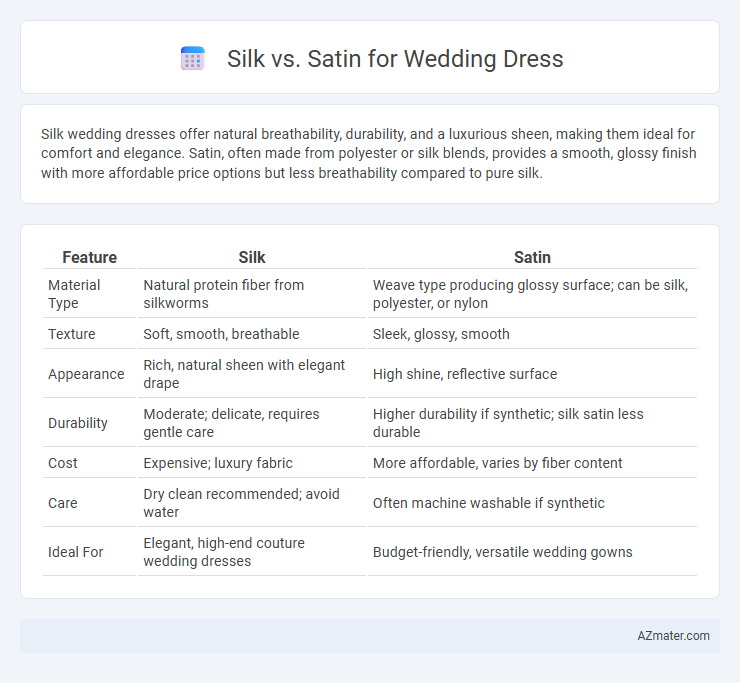Silk wedding dresses offer natural breathability, durability, and a luxurious sheen, making them ideal for comfort and elegance. Satin, often made from polyester or silk blends, provides a smooth, glossy finish with more affordable price options but less breathability compared to pure silk.
Table of Comparison
| Feature | Silk | Satin |
|---|---|---|
| Material Type | Natural protein fiber from silkworms | Weave type producing glossy surface; can be silk, polyester, or nylon |
| Texture | Soft, smooth, breathable | Sleek, glossy, smooth |
| Appearance | Rich, natural sheen with elegant drape | High shine, reflective surface |
| Durability | Moderate; delicate, requires gentle care | Higher durability if synthetic; silk satin less durable |
| Cost | Expensive; luxury fabric | More affordable, varies by fiber content |
| Care | Dry clean recommended; avoid water | Often machine washable if synthetic |
| Ideal For | Elegant, high-end couture wedding dresses | Budget-friendly, versatile wedding gowns |
Introduction: Choosing the Perfect Wedding Dress Fabric
Silk and satin are two of the most popular fabrics for wedding dresses, each offering unique textures and finishes. Silk is a natural fiber known for its luxurious softness, breathability, and elegant sheen, making it ideal for comfortable all-day wear. Satin, often made from silk or polyester, features a smooth, glossy surface that creates a striking, sophisticated look perfect for dramatic and structured designs.
What is Silk? An Overview
Silk is a natural protein fiber produced by silkworms, prized for its luxurious texture, natural sheen, and breathability, making it an ideal choice for wedding dresses. Its smooth, soft surface drapes elegantly, offering both comfort and a sophisticated appearance that enhances bridal gowns. Known for durability and hypoallergenic properties, silk wedding dresses provide a timeless, high-quality option compared to synthetic fabrics like satin.
What is Satin? Key Characteristics
Satin is a luxurious fabric known for its smooth, glossy surface and matte underside, created through a distinctive weave technique that produces a lustrous finish. Key characteristics include a silky texture, high sheen, and excellent drape, making it a popular choice for elegant wedding dresses. Satin can be made from various fibers such as silk, polyester, or nylon, offering affordability and durability alongside a glamorous appearance.
Silk vs Satin: Texture and Appearance
Silk wedding dresses feature a natural, smooth texture with a subtle sheen that exudes luxury, while satin offers a glossy, highly reflective surface due to its weave structure, creating a more dramatic shine. Silk's breathable, soft fibers provide a lightweight, flowing drape, ideal for comfort and elegance, whereas satin's synthetic or silk blends offer a heavier, structured feel that enhances the dress's formality and shape. The distinct difference in texture and appearance between silk and satin directly influences the wedding gown's visual impact and tactile experience, crucial for brides seeking the perfect balance of sophistication and comfort.
Comfort and Breathability for Brides
Silk offers superior natural breathability and moisture-wicking properties, making it an ideal choice for brides seeking comfort during long wedding ceremonies. Satin, often made from synthetic fibers like polyester, tends to trap heat and moisture, which can lead to discomfort in warm or humid conditions. Brides prioritizing all-day comfort typically prefer silk for its softness, temperature regulation, and luxurious feel against the skin.
Durability and Maintenance Comparison
Silk wedding dresses offer superior durability due to the natural strength of silk fibers, making them more resilient to wear and tear compared to satin, which is often made from synthetic fibers or a silk-polyester blend. Maintenance for silk requires careful hand washing or professional dry cleaning to preserve its delicate texture and sheen, while satin tends to be easier to clean and more resistant to wrinkles but may lose its luster over time. Choosing between silk and satin depends on balancing the bride's preference for long-lasting fabric versus convenience in garment care.
Cost Differences: Silk vs Satin
Silk wedding dresses typically cost significantly more than satin due to the natural fibers and labor-intensive production process involved in harvesting and weaving silk. Satin, often made from synthetic fibers like polyester or nylon, offers a more affordable alternative while still providing a glossy, smooth finish suitable for wedding gowns. Brides considering budget constraints often choose satin for its lower price point without sacrificing the elegant sheen that characterizes both fabrics.
Ideal Wedding Styles for Each Fabric
Silk, known for its natural sheen and breathable texture, is ideal for classic and vintage wedding dresses, enhancing elegant styles like A-line and ball gowns with a luxurious drape. Satin offers a smooth, glossy finish and heavier weight, making it perfect for structured silhouettes such as mermaid or sheath dresses that require body and shape retention. Brides seeking a timeless, romantic look often choose silk, while those opting for dramatic, modern designs tend to favor satin for its lustrous surface and durability.
Pros and Cons: Silk Wedding Dresses
Silk wedding dresses offer a luxurious, natural fabric that provides excellent breathability, a smooth texture, and a timeless shimmer ideal for elegant ceremonies. The primary advantages include durability, hypoallergenic qualities, and a comfortable fit that adapts well to body contours, enhancing the dress's aesthetic appeal. However, silk is prone to water stains, requires delicate care, and typically comes at a higher cost compared to synthetic satin options, making it less practical for budget-conscious brides.
Pros and Cons: Satin Wedding Dresses
Satin wedding dresses offer a smooth, glossy finish that enhances the gown's elegance and provides excellent structure for voluminous designs. The fabric is durable and resists wrinkles, maintaining a polished appearance throughout the wedding day, but it can be heavy and less breathable, which may cause discomfort in warm climates. Satin's luxurious sheen is ideal for formal weddings, though it can highlight imperfections in the gown's construction due to its reflective surface.

Infographic: Silk vs Satin for Wedding Dress
 azmater.com
azmater.com